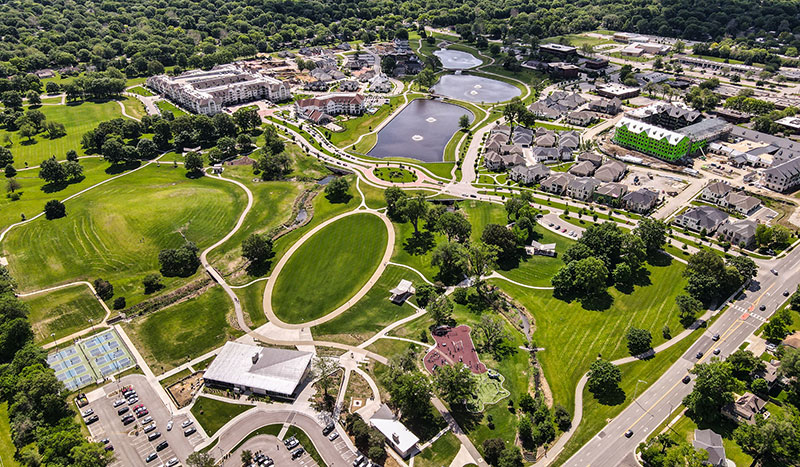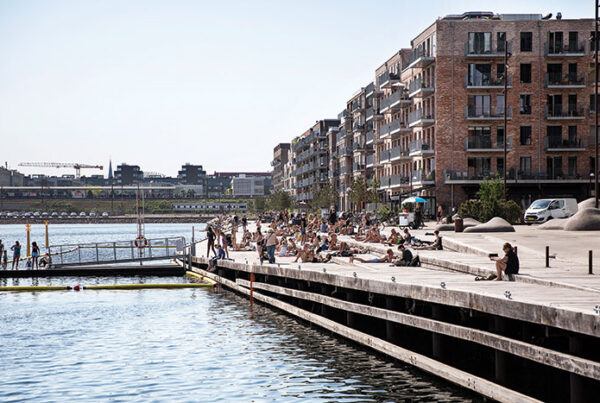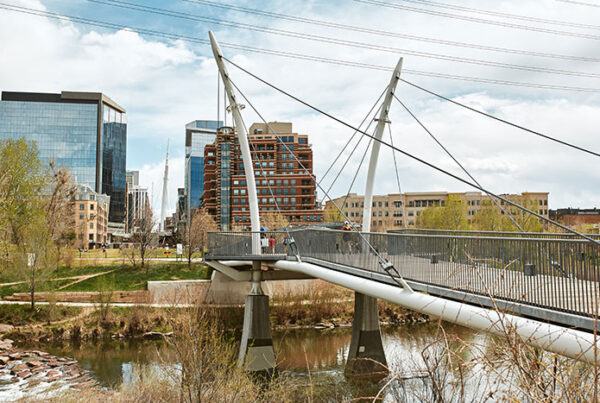July is Park and Recreation Month, and ULI is joining the National Recreation and Park Association (NRPA) to celebrate parks and the essential role they play in communities. Throughout the month, ULI is showcasing resources on parks, highlighting information on the benefits and value of high-quality and accessible parks for all, and amplifying the work of members who are championing parks.
Here, a diverse group of five ULI members—including a developer, a designer, a former elected official, and more—share their perspectives on the importance of real estate industry support for parks and their own experiences with championing parks as land use professionals, and as park users themselves.
A series of questions prompted each member to write about one thing—e.g., one motivation, one experience, one park—related to the importance of parks. We received responses representing the wide range of benefits that parks offer and the many ways they are valuable to both communities and real estate. Accompanying their abridged responses, photos illustrate each person’s recommendation for the one place people should try to visit to see a good example of a high-quality park.

Marcel Acosta recommends visiting Meridian Hill Park in Washington, D.C., saying it is an elegant, historic park with cascading waterfalls and terraces—a great example of parks serving as a place where people from all walks of life come together. (National Capital Planning Commission)
What’s the one thing you wish the real estate industry knew about how to support parks, or how to make park access more equitable?
Marcel Acosta: It is not enough to build a park and expect people to come. Today, all parties need to focus on the user experience. We need to address the nature of public space to ensure that everyone has equal access and feels welcome. Addressing equity requires taking a broader approach—finding ways to connect the various parts of the community, ensuring that everyone who wishes to use the space feels safe, and carefully listening to develop a program to accommodate diverse needs. However, I would caution against recent design trends to over-program and over-design park space. Encouraging more flexibility and openness might provide the public with more meaningful opportunities to use the space in passive and active ways. Sometimes you should allow for serendipitous moments and give users the ability to adapt the space for their present and future needs.
Justin Duff: From a real estate perspective, I’ve seen firsthand the benefit of having a green space in close relationship with private development. The park amenity provides equal access to green space, brings people in the community together, promotes inclusion, and fosters a healthy lifestyle. As real estate developers, we understand the benefits of incorporating park space into the site planning efforts. This has a positive impact on the quality of the development, but also increases the quality of life for people in the community.
Glenda Hood: The real estate and development communities must recognize the value of parks and green spaces as enhancements and a positive return on their investments. When appropriate and innovative design is utilized, parks and green spaces add attractive and complementary expansions of development projects, offer active or passive gathering areas for both employees and visitors, as well as make strong statements toward incorporating public art and a commitment to the environment in urban settings. Bottom line: it’s good for business!
Riki Nishimura: A successful park experience is everlasting and transforms over time. The park design and park experience should evolve with the community and grow in sync with nature as it matures. Parks require regular maintenance, investment, upgrading and improvements, and periodically a redesign to ensure that it is culturally relevant, easily accessible, and demonstrates a purpose for the users.
Allison Schapker: “If you build it, they will come” is no longer a viable strategy. Successful and equitable parks require intention and long-term partnerships. In many communities that have seen disinvestment, parks are ground zero for civic commitments to be made or broken. Parks are where residents decide if the operator, whether a municipality or private entity, cares about them. We demonstrate care through asking residents and delivering on those commitments.

Justin Duff recommends Meadowbrook Park in Prairie Village, Kansas, which more than doubled the amount of park space in the city, as a high-quality park to visit.
What one experience led you to become a parks champion?
Acosta: When I worked at the Chicago Department of Planning and Development in the 1990s, we developed the Chicago River downtown corridor plan. This effort exposed me to the power and potential of parks to improve the quality of our cities’ physical environment and social life.
Duff: Fully realizing the importance of incorporating green space into a development such as Meadowbrook Park, we have seen the positive impact of private development interwoven with public green space. Parks provide an opportunity for play and exercise that are an important part of our well-being, no matter our age. By incorporating easily accessible green spaces in our development efforts, we can naturally improve social cohesion and interaction.
Hood: My memories from childhood of the park across from my downtown school are of a place where we played, learned, felt safe, and created memories with classmate friends. Perhaps without realizing at the time, parks and green spaces became significant and necessary parts of my life and made me a champion to ensure that my community focused on the creation of new, expansion of existing, and protection of those special places that bring us together.
Nishimura: After visiting multiple neighborhood parks across the nation, I realized that several parks were just passive green spaces with some lawn and trees. Although there was activity in the area, with kids playing in the streets and people walking dogs on the sidewalks, there was no one in the park since it was not designed to function as an experiential place for people. Parks are only effective when they have users.
Schapker: It’s personal for me. Just out of college, I had the good luck of landing an apartment near the incredible, Olmsted-designed Cherokee Park in Louisville, Kentucky. A few years later, I worked at an office on Hampstead Heath in London. Both times, I was a newcomer to the city, and these parks became the living spaces I lacked in my studio apartment! Through parks, I got to know my new home, meet my neighbors, and participate in the life of the city. The math and metrics around the case for open space and the value creation provided by parks came later as I wanted to find ways to deepen the public space investment in the places I work.

Falls Park in downtown Greenville, South Carolina, incorporates all the elements of a near-perfect park in the heart of the city, says Glenda Hood. Today, residents and visitors can enjoy the trails for walking and biking along the Reedy River’s edge, where children can wade across the rocks and marvel at the water cascading down small waterfalls, and where the thoughtfully designed features of a suspension bridge, landscaping, and public art seamlessly support the environmental features. It is a respite that connects to other trails and parks in the center of a vibrant urban setting of residences, businesses, retail and restaurants, and cultural and sports venues.
What’s the one thing that will have the greatest impact on parks within the next year?
Acosta: Parks now have a much stronger connection to our public health efforts. This next year is the perfect opportunity to build upon the momentum that emerged from the public’s heightened awareness of the importance and value of parks and open space during the pandemic. As we reopen, the public realm will become an even more critical asset to our workplaces and neighborhoods since workers and residents alike have valued park space and will demand these amenities for their well-being.
Duff: Parks have been reintroduced into many people’s day-to-day recreation, driven by the pandemic. One of the strongest emerging trends this year is the focus on health and health equity. I’m hopeful that the movement toward health as well as mental and physical well-being will continue beyond the pandemic and will bring greater focus on meeting the social needs of communities.
Hood: Following the financial strains from the pandemic, many cities are reprioritizing spending, and, unfortunately, parks development and maintenance may suffer. This is the opportunity for ULI and the National Recreation and Park Association to join with other champions, especially from the private sector, to emphasize parks’ social and equity benefits along with all the recognized positives for our communities. There is also a new army of advocates in neighborhoods across the country who should be mobilized to assist in making the case for more and better access to our parks.
Nishimura: During the pandemic, cities have realized that having access to a park and open space was a necessity. The greatest impact on parks will be overcrowding in the next year. We must ensure that parks can accommodate a larger capacity of people and provide opportunities for spaces that can function for various activities in the sun and/or shade for both active and passive uses.
Schapker: We spent much of the last year learning how parks and public spaces are critical to the resilience of our communities. While the world shut down, parks stayed open. Not only did we ask our parks to accommodate more people, we asked them to be more things for our residents. This year, the single greatest impact on parks will be whether we pay parks back and make meaningful investment of recovery funds in our public spaces. Will we finally recognize parks as civic infrastructure that demands more than the loose change under the municipal couch cushions? Will we create a national strategy for investment in civic infrastructure?

Riki Nishimura recommends Golden Gate Park in San Francisco as a high-quality park not only because it offers something for everyone at multiple scales, but also because the park experience and programs evolve with the city and the community. (Shutterstock)
What is your number-one reason why parks are essential?
Acosta: Can you imagine our neighborhoods, towns, cities, or regions without parks and open spaces? It’s a truly unique land use that simultaneously achieves so many important public goals. Parks not only provide recreation, help the environment, improve our general health, connect places, and promote social cohesion, but it’s also good business. Parks can add value to nearby property and provide much-needed amenities to the surrounding community. In the past, we’ve often treated parks and open spaces as an afterthought and not as an essential part of our public policy as housing and jobs. It’s high time that we give our parks and open spaces the same level of attention and care.
Duff: Parks serve diverse populations, promote physical activity, and, most importantly, they are a great way for family and friends to enjoy each other.
Hood: The one essential benefit of parks where we must focus and further develop is exposure to first chances for so many young people who are confined to their small urban environment due to economic or circumstantial situations. Today, parks can be that chance for youth to learn, create, share, and be lifted beyond their current circumstances toward a more advantaged and equitable future. As we develop these community spaces in the years ahead, we must do so with all our young people as priority.
Nishimura: Parks are essential because they provide the necessary breathing room within cities for successful growth and urbanization. Making connections to nature is the key to well-being and healthy living. Excellently designed and accessible parks make it possible for all citizens and visitors to have a safe place to meet, talk, play, relax, participate in active recreation, entertain, and enjoy food and beverages while evolving with the neighborhood and community they serve.
Schapker: Parks are essential because nature, beauty, and community are essential to being human. Parks make our cities humane.

West Fairmount Park in Philadelphia is a strong example of a high-quality park, which is the result when communities, programming, capital, and maintenance structures are aligned, says Allison Schapker. In partnership with the Philadelphia Water Department, the Streets Department, and Parks and Recreation, the Fairmount Conservancy has implemented over $6 million in park improvements that provide safe pedestrian crossings and bike routes, establish green infrastructure, and offer a setting for neighbors to gather in shade.
For the rest of Park and Recreation Month, we invite you to help champion parks. Share why parks are important to you on social media using the hashtag #ULIParkChampion, and your post may be featured on ULI channels. To learn more about ULI’s resources on parks and open spaces, visit uli.org/parks.




